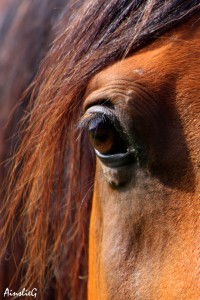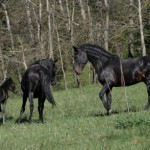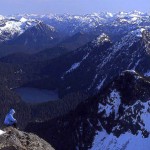Archive for the ‘Uncategorized’ Category
Herbal First Aid For Horses
An excerpt from Robert’s Online Book: Herbal Horsekeeping
Herbs and Trauma
Because of their reactive natures as flight animals and the confined conditions in which we often keep them, horses are inclined to injure themselves. This applies to the times when they are at liberty in the pasture, when being ridden, and, particularly, when they are being transported (See Chapter 8: Herbs and Travel).
Swift and appropriate first aid can go a long way towards minimizing the severity and long term effects of any trauma or accident, and herbal medicine provides horse owners with the means. … Read the rest of this entry »
EMOTIONAL BALANCING FOR YOUR HORSE
Just like us, our horses get unbalanced. The typical way of noticing this is to assess their physical conformation or bio-mechanics, however I am referring to something much more powerful. I am referring to their emotions. By combining both Tellington-touch™, the work of Margrit Coates, Healing for Horses, Acupressure, and an intuitive sense of where these imbalances might be, it is amazing to see the incredible release that a horse can feel instantly.
conformation or bio-mechanics, however I am referring to something much more powerful. I am referring to their emotions. By combining both Tellington-touch™, the work of Margrit Coates, Healing for Horses, Acupressure, and an intuitive sense of where these imbalances might be, it is amazing to see the incredible release that a horse can feel instantly.
Horses have an energy system just like us known as the Chakras, and just like us this system can become unbalanced and blocked. Blockages may present as aberrant emotions like anger, sadness, anxiety, lethargy – things you may not be used to seeing in your horse.Did you know that your horse’s heart chakra actually has four distinct points? To locate the heart chakra, place one hand gently just behind the withers, and one hand on the front of the chest in the flesh part. You now have located a direct line between two of the points.
While gently standing with your horse, bend your knees slightly, soften your eyes, bring your shoulders down and allow your breath to flow into your belly. Say these words “I love you and I will always be with you. It is okay to release whatever you are carrying, whether mine or yours.”
Give your horse the gift of healing today, and write back and let me know how it went (or even book a session with me so that I can help you learn how to do this most effectively on your own)
Here is what one person recently said about their Emotional Balancing Session I provided to their horse.
Linda-Ann Bowling
Master Intuitive Coach and Healer
Natural Habitat…
Here are 2 lovely videos from Joe & Kathleen Camp’s blog…explaining how they created as natural an enviroment as possible for their horses on under 2 acres of land,
Of course we can’t all afford to give our horses hundred’s of acres to roam on, BUT we can do the best with what we have and this is a great example of that…over the next few weeks I will do more posts on natural boarding models (both simple time saving ones as well as the more complex ones) as well as explaining how horses are designed to live.
Enjoy!!
Here Joe explains how they setup their ‘paddock paradise’ (first 7 mins of the video) and then it shows him doing the morning feed and then laying out the hay throughout the track, and then the final segment shows the horses on the track and their response to it. Very interesting- do take the time to watch!
[youtube]http://www.youtube.com/watch?v=bTI4afF3JA8[/youtube]
This is just the ‘Dancing Barefoot’ part…
[youtube]http://www.youtube.com/watch?v=4a7-9ErSWK8[/youtube]
Be sure to check out www.TheSoulofaHorse.com to find out more about Joe’s Book and also their recent move to Tennesee!
The Business of Going Bitless…
I found a lovely website this evening called TheSoulOfAHorse.com. It is run by Joe & Kathleen Camp and its a wonderful visual journey of their path into Natural Horsemanship. I have selected one of Joe’s articles called ‘One Good Reason to Go Bitless’. I hope you all enjoy it and be sure to visit their website! They have several other blog articles & videos that I look forward to sharing over the next little while!
One Good Reason to Go Bitless?
by Joe Camp
Sometimes I think I’m really stupid. Like back when I thought that metal shoes nailed to a horse’s hoof seemed to be the right thing to do. I didn’t question it. In fact, I wanted to know why Cash came to us with only shoes on his fronts, none on his backs, when everyone was saying a horse’s hoof would disintegrate without the protection of a metal shoe. That’s precisely what I was told. Enough said. And I didn’t question it. That’s what makes me feel so stupid. I didn’t question it.
Then one day I read that a horse’s hoof was supposed to flex. And that flexing has a purpose. It circulates blood, which promotes a healthy foot, and provides a hydraulic type of shock absorption for the joints, ligaments, and tendons of the leg. And it helps the heart pump blood back up that long leg. The ramifications of shutting down that flexing by nailing a shoe on the hoof are huge and onerous (see barefoot). The horse has survived for millions of years quite well without shoes, and being a prey animal, a flight animal, his hoof is about the most important thing he has for survival. Sufice to say all of our horses are now barefoot with rock crushing feet, good to go on any surface. We are doing well by our horses.
Take two.
I received a note from Sheila Thompson in the UK praising our website… then asking me if I had tried a bitless bridle. Here I go again feeling stupid. I am professing to care about our horses, how they feel, what is best for them, and I never blinked at placing a piece of metal across a bone in their mouthes (Call it “bars” if you want to. It’s bone) and leaving it there for hours on in, never mind how light I think I am with the reins. I had never thought about it. Stupid.
Without realizing it, Sheila shamed me into giving one of Dr. Cook’s Bitless Bridles a try (she’s the UK rep for Dr. Cook). We ride a lot in just a halter, but only on the property, and in our small arena. Never out on the trail. Why? I can only rationalize thoughts about our own safety. Not the horse’s well being.
I ordered two of Dr. Cook’s Bitless Bridles and his short but powerful book Metal in the Mouth. Holy moly! There are so many things wrong with a metal bit in a horse’s mouth that I really felt ashamed. I won’t re-write Dr. Cook’s book here. It’s all available on his website http://www.bitlessbridle.com but I’ll relay a couple of concepts that got to me right off the bat:
-
Metal on bone. Think about it. Picture a couple of your teeth missing on both sides and a metal bar resting on the remaining bone. A horse has a bunch of nerve endings running through that part of his mouth and a bit just resting there must be terribly uncomfortable at best, painful at worst. Now picture the way many folks jerk around on the reins. Pain-induced compliance. Instead of teaching. I can only blame fear for my resistance to removing the bit. Fear that if my horse ran off with me, no matter how much I cared for him and wanted to do right by him, I wanted to be sure I was able to stop him. Is a bit necessary to do that? No.
-
When anything goes into a horse’s mouth (anything!), it triggers a “food-is-coming” reaction in the brain causing the brain to open the flap between the lungs and the stomach so the “food” it thinks is coming will go to the stomach, not the lungs. Thus a horse with a bit is in his mouth is not getting the full load of oxygen that he would be getting if the flap were fully open to the lungs. And, of course, the bit is usually present when the horse is exercising, often heavily, and he needs that oxygen.
-
Have you ever seen a horse running with the herd, without any tack on? Was his mouth ever open? With a bit in his mouth, he almost always has his mouth open. Ask yourself why, and what problems that can cause. Dr. Cook answers those questions in depth on his website.
There are so many more negative issues caused by the bit, but I was won over in a fraction of a moment for one simple reason. Cash has always had issues that I had written off to his Arab-ness. As much as he is a lovely gentleman when I’m on the ground with him, under saddle he liked to go, and I mean go (or so it seemed). He didn’t like to maintain gait because he always wanted to go faster. He didn’t like to stop. And he didn’t like to stand still. We worked on those things a lot, Cash and me, and there was progress, but not a lot. He is, after all, an Arab.
When it finally quit raining enough this past winter for me to try this new fangled bridle, I was instantly amazed. Astounded, actually. All of those issues I had been writing off to Arab-ness were gone. Vanished! Cash would stop on a dime with just a sit-back, no pressure on the reins at all. He would stand there happily for half an hour if I didn’t nudge him forward. And he would maintain whatever gait I asked for.
Dr. Cook wasn’t surprised when I told him. Not even a little. He knows all the researched and scientific reasons why such reactions are caused by the bit, and he has heard thousands of stories like mine. But I’m still grinning. Cash is now the same wonderful guy under saddle that he is when I’m on the ground. We are truly one.
I urge you to not ignore this, for the sake of your horse and your sake as well. And, as I always say, don’t take my word for it either. Gather the information. Read Dr. Cook’s book and/or the information on his website, then give it a try. You will be amazed.
I would love to see this Bitless Bridle spread like wildfire so I gave Dr. Cook a small piece of marketing advice: “Forget the no-more-metal rhetoric, forget the pain, forget the cruelty – all of which are true – the darned thing just works better than a bit!”
Now all of our horses are bitless.
Yippee!
Joe
The link again: http://www.bitlessbridle.com
————————————
Joe Camp also wrote a bestselling book called ‘The Soul of a Horse’. Click here to read more or order this beautiful story!
HEALTHY HORSE TREAT RECIPES
Making homemade horse treats is one way to make sure that your horse is getting yummy treats with fresh and healthy ingredients straight from your kitchen. Mix up some healthy horse cookies and replace those sugar cubes in your pocket with something more nutritious. Read on to learn how to make healthy horse treats.
Oat ‘n’ Apple Chewies
INGREDIENTS: Read the rest of this entry »
UNDERSTANDING HORSE BEHAVIOUR
The first step to building a strong relationship with your horse is to understand why he is the way he is, what makes him react the way he does and basically- how the world looks from his eyes. A horse is not a human and to try applying the rules that govern our human society to the equine world is not only foolhardy and dangerous, but it is also cruel.
foolhardy and dangerous, but it is also cruel.
It may not make sense to us why he does some of the things he does, but to him it makes perfect sense. This is why we need to understand horse psychology in order understand our horse and once we understand him, maybe then and only then can we begin to teach and train him.
Today we will begin to explain the dynamic that is the horse and his herd.
Understanding Horse Behaviour
Horses originally lived on wide open plains and would Read the rest of this entry »
Winter Paddocks- Part 1
Winter is upon us and if you havn’t already prepared a proper ‘winterized’ paddock with clean, dry footing, out of the mud and slush, you’d better start planning and building one now!!
By Alayne Renee Blickle (from www.myhorse.com)
Tired of confining your horse in that muddy, dusty, smelly and fly-infested pen? Are you looking for some new ideas on how to care for your horse during the winter months or rainy season? Or wondering where to keep your horse before your pastures are on the brink of being over-grazed? Or when your horse is in need of a “diet pen”?
Having a horse-friendly, easy-to-care-for paddock for your horse is central to horse-keeping. The bonus for you is that having “the perfect horse paddock” will be better for your horse’s health, more chore-efficient for you, nicer for all to look at, and cleaner for the environment.
Probably the most important aspect of managing your pastures is the time when you take your horses off the land. Read the rest of this entry »
To Blanket Or Not to Blanket…part 1
By Cherry Hill
Even though a horse may be “turned out” for the winter because he is not in active work, he needs protection from wind, moisture and cold. Whether you blanket your horse or not depends on many factors including his condition, his activity level, his hair coat, his level of nutrition, and the protection offered by your facilities.
Actually, preparation for winter begins well before the first snow. In August and September, horses living in temperate climates should be allowed an increase in body weight of about 5%, but not more than 10%. A 1200-pound adult can gain Read the rest of this entry »
ARE YOU READY FOR ANOTHER WINTER?… IS YOUR HORSE? – Part 1
Another summer is winding to an end and horse owners need to make management plans for the cooler seasons ahead. For horses, cold weather does not mean coming in from the cold, but being assisted to withstand the cold as comfortably and healthy as possible. However, horses have special needs during the cold weather to assure they will stay healthy and in good condition. 
Horses are very tolerant of cold conditions; in fact, horses tend to be far more stressed by heat than by cold. From the horse owner’s standpoint, winter management gets very basic: routine health care, feed, water, and shelter. Any winter, be it mild or severe, will be easier to deal with if you have prepared in advance.
Assessing The Horses Condition:
For a horse to be an “easy keeper” during the winter he needs to be Read the rest of this entry »
GOLDEN EARS NATIONAL PARK: Riding the East Canyon Trail
(Photos at the botton of this article)
Location: Coast Mountains 11 km north of Maple Ridge on the north side of the Fraser River. Follow park signs north from Hwy 7. About 48m east of Vancouver going up the Fraser Valley. The nearest center is Maple Ridge B.C.
Size: The size of the park is 55,590 Hectares
History – The park was named after the twin peaks of Mount Blanshard near the peak’s western boundary. Originally part of Garibaldi Provincial Park, the establishment of Golden Ears Park in 1927 recognized the almost impenetrable mountain barrier between the two areas.
Cultural Heritage – Human activity in Golden Ears, both past and present, has been confined to the accessible Alouette Valley in the south of the park. In the 1920s, the forested slopes of the valley became Read the rest of this entry »


